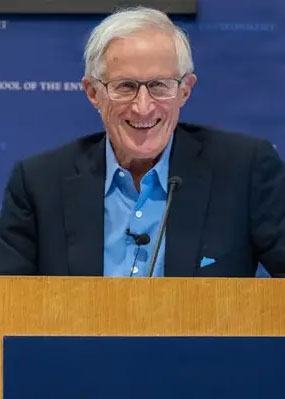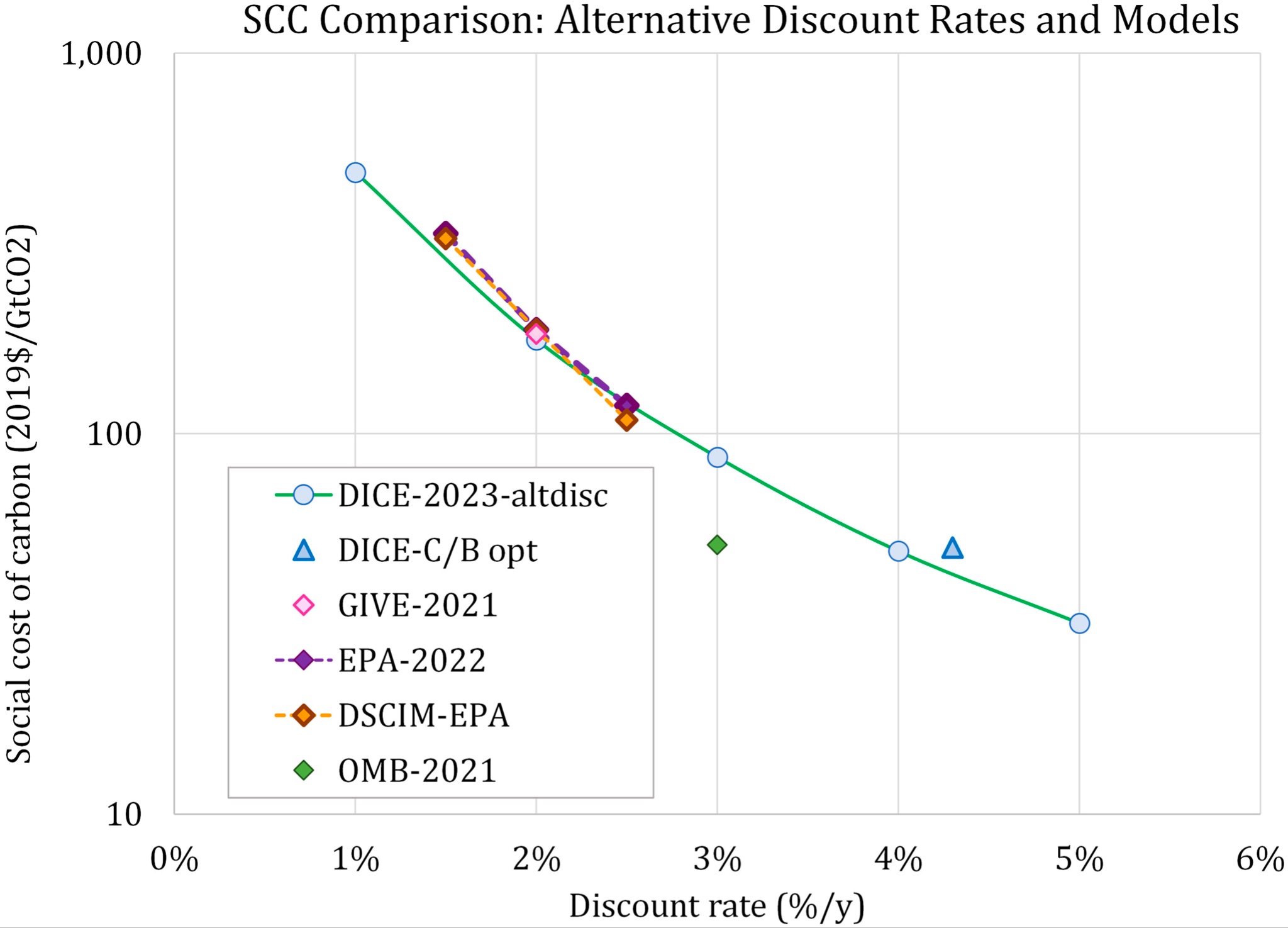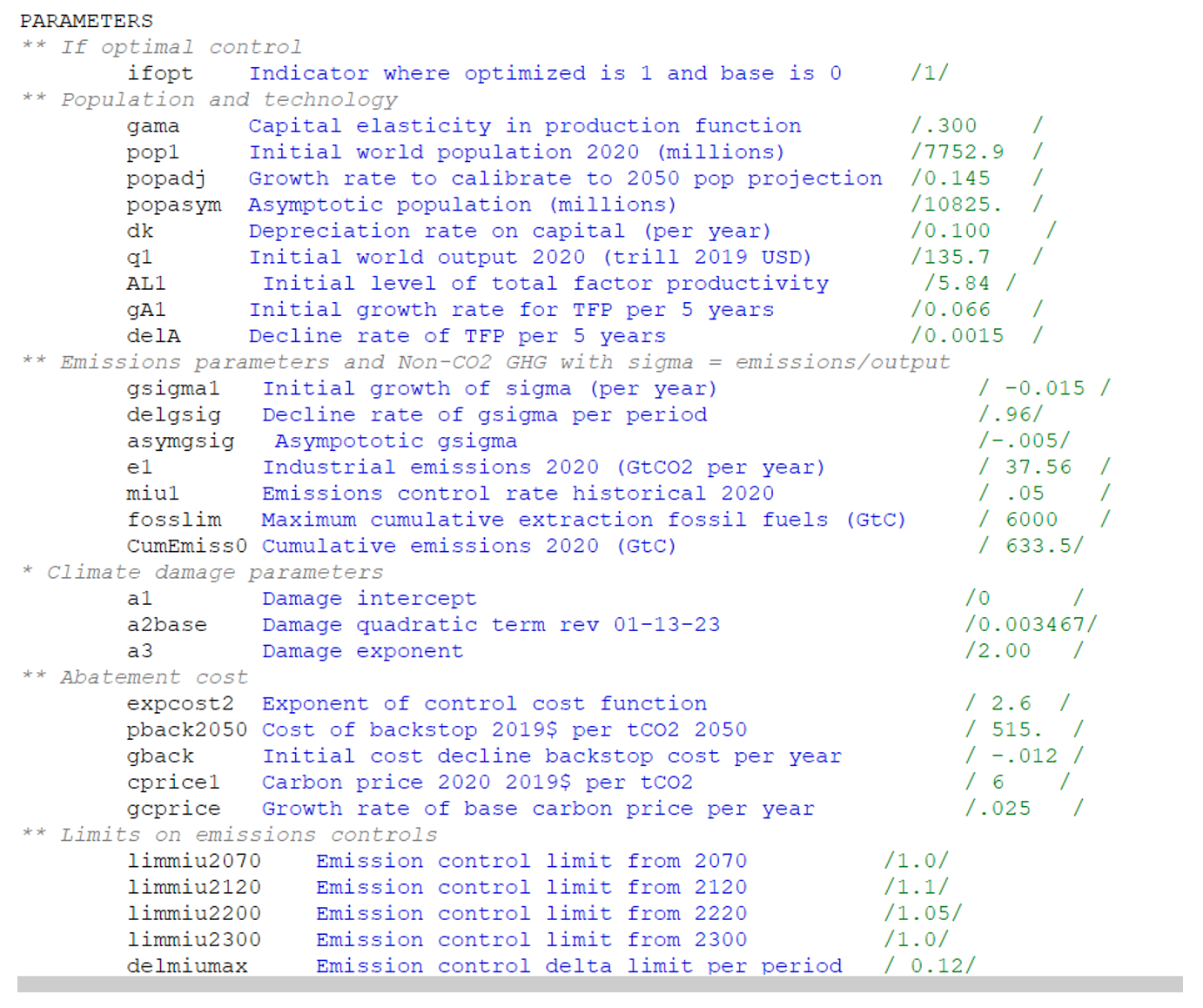The Economic Consequences of Climate Change: An Interview with Nobel Laureate William Nordhaus

William Nordhaus and Lint Barrage (PhD ’13)
What are the economic consequences and opportunities of climate change? How do you integrate economic analysis with the science of climate change?
These questions are at the heart of Nobel laureate William Nordhaus’s career, and in research released this week in the Proceedings of the National Academy of Sciences (PNAS), he and coauthor Lint Barrage (PhD ’13) present new findings from the updated DICE-2023 model, with major implications for global climate policy.
The DICE model (the Dynamic Integrated model for Climate and the Economy) is one of the first integrated assessment models or IAMs. This approach provides policy-relevant insights into global environmental issues through quantitative descriptions of key processes in human and earth systems. IAMs model the climate problem from end to end, from economy to emissions to atmospheric chemistry to climate dynamics, then on to impacts such as sea-level rise, wildfire, and health impacts, and finally closing the loop by including policies to bend the curve of CO2 emissions. The outputs of these models play a key role in understanding key relationships and formulating efficient policies to slow or reverse the trends.
One important finding is that international climate policy has set ambitious goals but has failed to establish an architecture for implementation…Additionally, we estimate that current policies will lead the global mean temperature increase (above pre-industrial levels) to pass the 1.5 °C target later in this decade, while without major policy changes, the globe will surpass the 2 °C goal of the Paris Accord by mid-century.”
- William Nordhaus
The original DICE model was developed and published at Yale in 1992 and is the most widely used climate-change integrated assessment model. The US and other governments employ it to calculate the social cost of carbon, as well as create consistent scenarios and evaluate policies and uncertainties. The new study updates the 2016 DICE model with revised treatments of the carbon cycle, damages, discounting, and also includes results on the Paris Accord and temperature-limited scenarios.

Among the key findings from the new study, the authors note that both current policies and the extended Paris Accord fall far short of limiting global warming to 2 °C. They also highlight the substantial economic stakes at play in global climate policy: in the efficient scenario, where climate change policies maximize economic welfare according to the principles of cost–benefit analysis—they estimate a net present value of economic benefits of around $120 trillion.
Journal Publication
 Policies, projections, and the social cost of carbon: Results from the DICE- 2023 model
Policies, projections, and the social cost of carbon: Results from the DICE- 2023 model
Proceedings of the National Academy of Sciences (PNAS)
In the Q&A below, author and Nobel laureate William Nordhaus discusses the key findings and implications of this new research.
What are the major new findings today? What are the major surprises?

One important finding is that international climate policy has set ambitious goals but has failed to establish a realistic architecture for implementation. This is seen in the “price of carbon” (or the cost to polluters of emitting CO2 into the atmosphere) that is far below the level necessary to reach international goals. We estimate that a global carbon price of $80 per ton of CO2 would be necessary to reach the goals of the 2015 Paris Accord. Yet, the World Bank estimates that the current global price is only a tiny $3 per ton.
Additionally, we estimate that current policies will lead the global mean temperature increase (above pre-industrial levels) to pass the 1.5 °C target later in this decade, while the globe will surpass the 2 °C goal of the Paris Accord by mid-century without major policy changes. All this might not be a big surprise – perhaps alarm is a better word. Professor Barrage and I emphasize that it is critically important to recognize how countries’ climate policies fall so far short of their rhetoric and goals, and this is borne out by the recent release of DICE 2023.
What does this new study say about the “social cost of carbon”?
This critical measure (“SCC” for short) is the most important single economic concept in the economics of climate change. It designates the current and future damages caused by an additional ton of carbon dioxide emissions or its equivalent. The SCC has become a central tool used in climate change policy, particularly in the determination of regulatory policies that involve greenhouse gas emissions. The SCC has been used by the US government in rules that provide more than $1 trillion in benefits. Integrated models like DICE are essential to the calculation of the SCC and have been used by many governments in their formulation of climate policies.
We estimate that the SCC is around $80 per ton of CO2 in today’s dollars. With about 5 billion tons annually of emissions, this represents a debit of about $400 billion for the US economy (out of a total output of $28 trillion). This is a useful finding because it shows again how inadequate climate policy is because current carbon prices are so far below our estimates of SCC. The figure below shows alternative estimates of the SCC from the publication.

Figure 4 from the article shows the relationship between the social cost of carbon and the discount rate for different scenarios of the DICE-2023 and several other models.
What suggestions for climate policy emerge from your work?
Looking at the landscape of climate policy, we see three necessary aspects of an effective policy.
The first, mentioned above, is that countries need to raise carbon prices sharply to provide appropriate incentives for the private and public sectors to reduce emissions. This cannot be done overnight, obviously, but we need to move forward with this critical step as soon as possible. Here in the United States, there is an unusual opportunity because major tax provisions expire next year, and we face the need to either raise income taxes substantially or find other revenue sources. This would be a good time to replace the scheduled increases in income taxes with taxes on carbon emissions.
The second step is to replace the flawed international architecture on climate policy with a structure with carrots and sticks for incentivizing countries to participate in strong policies. I have called this the “climate club” to suggest a structure of pricing policies along with penalties for countries who do not participate. The flawed structure of current international agreements is a major reason why so little progress has been made to curtail carbon emissions to date.
The final step is to recognize that a policy of decarbonizing our economies will require major new technologies – ones that are only in the laboratories or at small scale – and that these need strong government fiscal support. Examples of such technologies are advanced renewables, negative-emissions technologies, and futuristic technologies such as fusion, advanced nuclear, and superconducting networks.
The most important support would be government subsidies for fundamental and applied research on green energy technologies. It is striking how little governments have recognized the importance of this aspect of climate policy. Major countries today provide only $40 billion of support for green energy R&D. This is less than half of the money that companies in the United States devote to research and development in pharmaceuticals. We do not have a prayer of reaching our climate goals without strong government research support.
These three steps are hardly revolutionary in concept, but they are awesomely challenging politically. They are the best chance for the community of nations to prevent the growing threats to humans and the global environment of rapid climate change.
The modeling behind DICE-2023 sounds like a major enterprise. Are these models complex to code and calculate?
The models themselves are relatively small compared to many scientific studies (you can see some representative code below). But they have a particularly complex structure because they are “optimization models,” which means that they solve for the least-cost or highest-value path of the variables.

If you excuse a little excursion into geekiness, I will explain a bit more. The simplest version of DICE has 1475 variables and 1381 linear and nonlinear constraints.
Solving this problem would not have been remotely possible without modern mathematics, software, and hardware, but today’s PCs can solve it in only 1.3 seconds. One interesting feature is that the solution is so fast and robust because of the development of an algorithm known as “linear programming,” by Yale economist Tjalling Koopmans, for which he won the 1974 Nobel Prize in Economics.
What has been Yale's role in the development of integrated models like DICE?
Yale has been in the forefront of integrated climate-economic modeling for decades. Contributors to earlier DICE-related studies over the years have been Yale scholars such as Robert Mendelsohn and Ken Gillingham at the Environment School and Economics Department faculty such as Tony Smith (Chair of Economics) and Sam Kortum. Yale-derived work has pioneered DICE spinoffs, such as multi-region versions, ones introducing uncertainty, approaches with research and development, and learning by doing.
I would emphasize, however, that each new study and every passing year reveal new complexities and challenges. A world aflame with wildfires, and New Yorkers sheltering from record-setting pollution from Canadian fires, are the surprises that await us in the years ahead if unchecked warming continues.